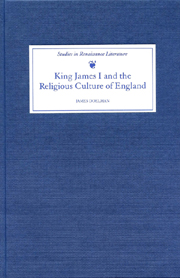Book contents
- Frontmatter
- Preface
- Chapter 1 BEGINNINGS: THE ROOTS OF JAMES' ROLE IN RELIGIOUS CULTURE
- Chapter 2 THE ACCESSION OF KING JAMES I AND ENGLISH RELIGIOUS POETRY
- Chapter 3 PROPHETS AND THE KING
- Chapter 4 KING JAMES, ANDREW MELVILLE AND THE NEO-LATIN RELIGIOUS EPIGRAM
- Chapter 5 FROM CONSTANTINIAN EMPEROR TO REX PACIFICUS: THE EVOLVING ICONOGRAPHY OF JAMES I
- Chapter 6 KING JAMES AND THE POLITICS OF CONVERSION
- Chapter 7 THE SONGS OF DAVID: KING JAMES AND THE PSALTER
- Chapter 8 THE DEATH OF SOLOMON
- WORKS CITED
- Index
Chapter 5 - FROM CONSTANTINIAN EMPEROR TO REX PACIFICUS: THE EVOLVING ICONOGRAPHY OF JAMES I
Published online by Cambridge University Press: 05 February 2013
- Frontmatter
- Preface
- Chapter 1 BEGINNINGS: THE ROOTS OF JAMES' ROLE IN RELIGIOUS CULTURE
- Chapter 2 THE ACCESSION OF KING JAMES I AND ENGLISH RELIGIOUS POETRY
- Chapter 3 PROPHETS AND THE KING
- Chapter 4 KING JAMES, ANDREW MELVILLE AND THE NEO-LATIN RELIGIOUS EPIGRAM
- Chapter 5 FROM CONSTANTINIAN EMPEROR TO REX PACIFICUS: THE EVOLVING ICONOGRAPHY OF JAMES I
- Chapter 6 KING JAMES AND THE POLITICS OF CONVERSION
- Chapter 7 THE SONGS OF DAVID: KING JAMES AND THE PSALTER
- Chapter 8 THE DEATH OF SOLOMON
- WORKS CITED
- Index
Summary
THE iconography of James I drew on a substantial number of previous models – biblical, imperial and British. William Germano, in an unpublished dissertation on dedications to King James, notes that “As early as 1604, James had been hailed as any number of biblical kings, as a Caesar (particularly Constantine and Titus), a Noah, someone vaguely related to Apollo or Apollo himself, Atlas, and even Homer.” Classical and biblical prototypes would often be brought together in describing James: Robert Burton describes him as “a wise, learned, religious king, another Numa, a second Augustus, a true Josiah”.
As I suggested in the preface, many recent scholars have concentrated on the classical iconography used to celebrate James' reign, especially at his accession. Correspondingly, the large body of biblical references applied to the king has been relatively neglected. Ultimately, there was perceived to be a closer correspondence between James and a biblical king than between him and a pagan emperor. Widely overlooked as well has been the important model that later Christian emperors such as Constantine provided for the iconography of the time. The emphasis on classical models may be a reflection of scholars' attention to drama and the masque: considerations of the iconography of James must move beyond the limited visual worlds of the theatre, architecture and art, to consider a wide variety of prose and poetry.
- Type
- Chapter
- Information
- King James I and the Religious Culture of England , pp. 73 - 101Publisher: Boydell & BrewerPrint publication year: 2000



